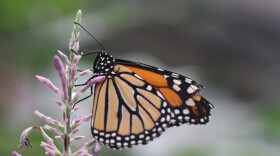-
On August 14, the Palisade Insectary marked its 80th anniversary as heroes of the Colorado agricultural community.
-
It’s not easy to spot fireflies on Colorado’s Front Range. Development and pesticide use have destroyed much of their habitat. But scientists at the Butterfly Pavilion hope to change that. We hear about a project that aims to bring fireflies back to the night sky.
-
Each year, the Butterfly Pavilion works with citizen butterfly observers to track the state’s butterfly populations. And the data they’ve collected shows that butterflies are declining in Colorado.
-
Every year around this time, hordes of tiny, winged creatures begin to invade the Front Range. That's right – it's miller moth season! And while many of us find them annoying, they’re also fascinating. We asked an insect expert to unpack some of the mysteries of the miller moth.
-
Grasshoppers are everywhere on the Front Range this summer. And the current blight could be just a taste of what’s to come in the next few years. We talk with a CSU insect expert to learn why the grasshoppers are here, and what we can do about them, on today’s In The NoCo.
-
Each spring, the Front Range endures miller moth season. Even in relatively mild years like this one, the tiny winged visitors annoy us … frighten us… and fascinate us. So we asked an insect expert to help us unpack the mysteries of the miller moths.
-
Researchers from the Rocky Mountain Biological Laboratory recently found that some winged insects native to the Mountain West – and crucial to maintaining ecosystem balance – are on the decline.
-
Each week, we talk with our colleagues at The Colorado Sun about the stories they're following. This time, The Sun's Editor and co-founder, Larry Ryckman, joined us to discuss some Colorado wildlife stories.
-
The Colorado Sun Editor Lance Benzel joined us to talk about a new bug swarming northwestern Colorado now that the moths are gone and a group of Denver renters who crashed a party for landlords with a protest.
-
APHIS monitors grasshoppers in 17 western states, and when the agency deems there’s an outbreak - or is asked to intervene by stakeholders like the US Forest Service or adjacent land owners - it can apply a pesticide to kill the insects.

Play Live Radio
Next Up:
0:00
0:00
Available On Air Stations









